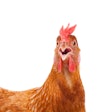
Rubén Martínez, CEO of Rujamar Poultry Farm in Cuenca, Spain, considers himself a fervent defender of animal welfare. For this reason, in June 2018, he determined to eliminate all cages on its layer farm to become the largest producer of cage-free eggs in Spain.
“I firmly believe in animal welfare. I never tire of saying that a caged hen is something that is not good for the animal,” said Martínez in an interview with WATT Poultry after receiving the Poultry Excellence Award on the 14th International Fair for Animal Production (FIGAN 2019), held in Zaragoza, Spain.
For Martínez, it was this commitment to “innovation, development” and animal welfare that led his company to receive this award.
Rujamar has 1.2 million layers that produce eggs in three modalities: organic, free-range and cage-free. In Europe, these modalities carry numbers that are placed on the eggs. The organic egg, identified with the number 0, is produced by hens with access to an outdoor area and fed with organic poultry feed. The free-range egg, which carries the number 1, is produced by hens with access to an outdoor area. And the cage-free egg, number 2, is produced by hens that do not live in cages but remain in sheds or closed buildings. The number 3 corresponds to the traditional caged production, but Rujamar has already left this modality in the past.
“My situation in the Spanish market is difficult. I am the largest cage-free producer. Facing a majority sector of cages, where they defend the cages, it is not easy,” Martínez acknowledged. However, he defended his decision and classified it as an advanced determination.
For this reason, WATT Poultry asked him about the recommendations he gives to other egg producers for the future.
1. Put fear aside and dare to be at the forefront
Although this is a significant investment of money and a possible confrontation with the traditional poultry production system, the CEO of Rujamar recommended that other producers put fear aside and dare to switch to a system that leads to greater animal welfare.
“As I have done, they can do it, he said. "This is a business opportunity right now. … Whoever does not get in the car and does not make the investments now, will pay in the near future, in the short- and medium-term”, he said.
Martínez added that soon the use of cages in animal production “is going to be banned, without a doubt,” even if it begins in European countries.
2. Think about animal welfare and product quality
Martínez acknowledged that caged egg production could lead to a larger number of units per bird and higher productivity. Nevertheless, he said that this does not result in animal welfare or a better product.
“If an animal lays through its beak, which egg is better? I don't know,” said Martínez. For him, in the traditional cage production, the nutritional requirements “are minimal,” contrary to alternative productions in which “you have to make richer [poultry feed] formulas” and “everything has to be more energetic” because the bird consumes more feed.
Also, he added that “animal welfare in a cage is conspicuous by its absence,” so if you think about animals, traditional production should be put aside, in his opinion.
Although in Spain it is not yet mandatory for producers to eliminate cages, Martínez argued that social and market pressure on poultry farmers would continue to increase.
In some European countries, such as the United Kingdom, there’s a lot of activism against animal production in cages. Some consumers worry about the origin of their food. So, by transitioning to cage-free production, “I think we are getting ahead of ourselves,” said Martínez, which would make a business more advantageous in the future.
3. Rely on specialized labor
“There is no experience with sheds with 200,000 laying hens. That is a bomb. Then, people panic,” said Martínez. This type of production with free-range hens could mean greater exposure to diseases and bacteria. That’s why it is fundamental to rely on “a lot of highly specialized labor,” he said.
Alternative poultry production may be more expensive, which would be reflected on the consumer’s price. However, Martínez said that eventually the costs “will be leveled” and could reduce as the number of free-cage animals increases.















